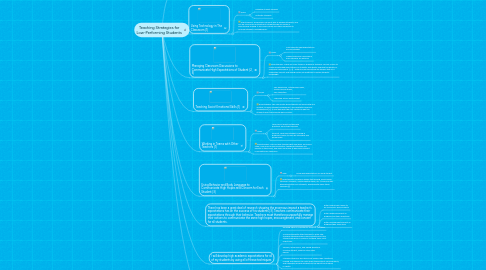Teaching Strategies for Low-Performing Students
by Stephanie Louris


1. Partnering with Parents by Communicating with Them [1]
1.1. Goals
1.1.1. Understanding student better
1.1.2. Increased student motivation to complete homework, work hard, and behave well in class
1.2. Effectiveness: This can give the teacher valuable background information about the student and ways to help him. Parents will vary in their time/inclination to reinforce teachers' expectations at home.
2. Teaching Social-Emotional Skills [1]
2.1. Goals
2.1.1. Self-awareness, interpersonal skills, social consciousness, self-regulation
2.1.2. Improved school environment
2.2. Effectiveness: This can greatly help students get along with one another, increase student achievement, and facilitate classroom management [a]. It may help with the root causes of why the students aren't performing well in school.
3. Working in Teams with Other Teachers [1]
3.1. Goals
3.1.1. Learn about effective teaching practices from other teachers
3.1.2. Find out how each student is doing in different classes to learn his strengths and weaknesses
3.2. Effectiveness: This can help teachers get new ideas from each other, form more uniform effective teaching strategies and policies in the school, and learn more how to help each student in his particular classroom.
4. There has been a great deal of research showing the enormous impact a teacher's expectations has on the success of his students [3]. Teachers communicate their expectations through their behavior. Teachers must therefore purposefully manage their actions to communicate the same high hopes, encouragement, and concern for all students.
4.1. Enter new product ideas to be turned into R&D-projects
4.2. Enter research projects in progress and their objectives
4.3. Enter development projects in progress their objectives
5. I will develop high academic expectations for all of my students by using all of these techniques
5.1. Emailing parents consistently with any concerns
5.2. Collaborating with other teachers to learn new teaching techniques and communicate about the students we have in common to teach them most effectively
5.3. Smiling, using humor, and asking questions of every student, ideally in each class period
5.4. Manage classroom discussions by asking "why" questions, making sure people use units when talking about measurements, and otherwise probing students to talk about the material in-depth
5.5. Using technology with project-based learning to motivate students and help them collaborate with each other
5.6. Being open and honest with students about their performance and ways to improve so that they gain self-awareness and motivation
6. References
7. Using Technology in The Classroom [1]
7.1. Goals
7.1.1. Enhance student learning
7.1.2. Motivate students
7.2. Effectiveness: Technology is a great way to engage students, and can be much more motivating to students who are bored or have trouble reading. It also uses visuals and other modalities to increase student comprehension.
8. Using Behavior and Body Language to Communicate High Hopes and Concern for Each Student [3]
8.1. Goal
8.1.1. Show high expectations for each student
8.2. Effectiveness: Research shows that smiling, using humor, calling on students, complimenting them, etc. communicates high expectations for students, which greatly helps them succeed [c]
9. Managing Classroom Discussions to Communicate High Expectations of Student {2, 3]
9.1. Goals
9.1.1. Communicate high expectations of each student
9.1.2. Making classroom discussions more valuable for learning
